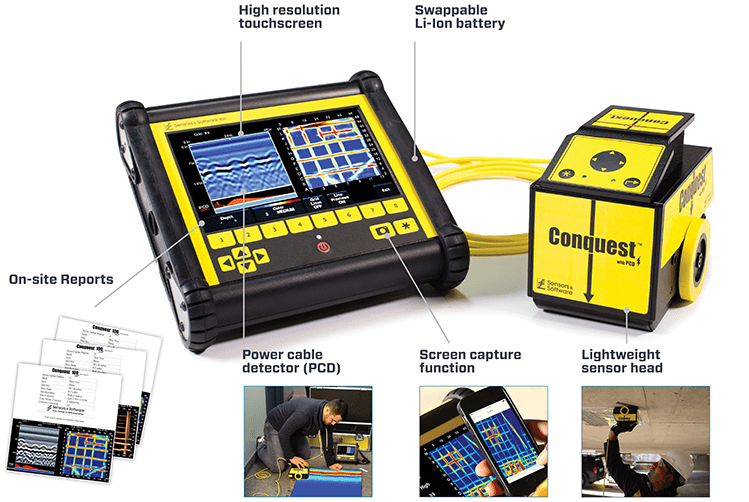Enhancing Job Planning and Execution Through Advanced Concrete Scanning Strategies
In the world of task planning and accuracy, insight and execution are essential elements that can make the difference between success and problems. Advanced concrete scanning methods have actually emerged as a sophisticated tool set to elevate the requirements of project administration within the building industry. By using innovative technology, these methods use a glance into the architectural stability of a building also before the first block is laid. The ramifications of such innovations are extensive, assuring a standard shift in just how jobs are come close to and provided.
Benefits of Advanced Concrete Scanning Techniques

Improved Precision in Job Evaluations
Enhancing task analyses through innovative concrete scanning strategies significantly enhances the precision and dependability of construction examinations. By utilizing advanced scanning innovations such as ground-penetrating radar (GPR) and 3D imaging, job teams can now get comprehensive understandings right into the condition of concrete structures, recognizing prospective flaws or weaknesses that may not be visible to the naked eye. This boosted degree of precision in project assessments enables building and construction specialists to make more educated choices concerning repair service and maintenance approaches, bring about improved general job results.
Additionally, the increased precision in task evaluations attained with innovative concrete scanning methods assists in decreasing the risk of unpredicted issues during the building and construction stage. By proactively finding hidden anomalies within concrete frameworks, such as rebar corrosion or spaces, job teams can deal with these issues early on, staying clear of expensive hold-ups and rework later on in the job lifecycle. Ultimately, the enhanced precision in task evaluations promoted by innovative concrete scanning strategies adds to better effectiveness, cost-effectiveness, and quality in building and construction tasks.
Very Early Identification of Architectural Obstacles
Early discovery of structural difficulties plays an important duty in guaranteeing the honesty and safety of concrete structures throughout the construction process. Recognizing prospective problems at an early stage permits for prompt treatment, preventing costly rework, routine hold-ups, and safety and security hazards. Advanced concrete scanning techniques, such as ground-penetrating radar (GPR) and 3D imaging, make it possible for task groups to reveal surprise issues, gaps, reinforcement design disparities, and various other abnormalities that can endanger the framework's security.
By carrying out these strategies during the planning and execution phases, building and construction specialists can proactively resolve structural obstacles prior to they intensify right into significant issues. For instance, discovering insufficient concrete cover over reinforcement bars beforehand can prevent rust and architectural informative post weakening over time - RainierGPR Service Areas. Additionally, identifying variants in concrete thickness or density can assist optimize product usage and guarantee uniform stamina properties across the framework
Eventually, very early recognition of structural obstacles through innovative concrete scanning not only enhances the overall high quality and resilience of the building and construction however additionally adds to a more secure built setting for individuals and owners.
Enhanced Safety Procedures in Construction
The application of durable safety and security protocols is critical in the building and construction market to minimize threats and safeguard the well-being of workers and stakeholders. To boost safety steps, building business are progressively taking on technical innovations such as wearable gadgets that keep an eye on employees' vital indicators and identify prospective health issues in real-time. By focusing on safety via the consolidation of advanced innovations and comprehensive training programs, building and construction jobs can significantly lower accidents and develop a safe functioning atmosphere for all entailed.
Streamlining Project Monitoring Processes
To optimize operational effectiveness and ensure job success in the building and construction industry, a concentrate on simplifying project administration procedures is important. By carrying More Bonuses out efficient project administration processes, building and construction tasks can reduce hold-ups, lower costs, and improve general performance. One key aspect of enhancing task management is the usage of advanced innovations such as Building Information Modeling (BIM) software, which makes it possible for real-time cooperation, clash detection, and accurate task organizing. In addition, the fostering of cloud-based job management platforms allows for smooth interaction amongst staff member, instant access to task information, and the capacity to track progression in real-time.

Final Thought
To conclude, the utilization of innovative concrete scanning techniques uses countless benefits for task planning and implementation. These techniques supply better accuracy in job analyses, early identification of architectural challenges, improved precaution in building and construction, and structured project administration processes. Including these methods into task workflows can eventually bring about much more successful and effective end results in construction projects.
Eventually, the enhanced accuracy in task assessments assisted in by innovative concrete scanning techniques adds to better effectiveness, cost-effectiveness, and high quality in construction projects. RainierGPR Service Areas.
To maximize operational efficiency and make certain job success in the building sector, a focus on streamlining task management procedures is necessary. By executing reliable job management processes, building and construction jobs can decrease delays, reduce expenses, and boost general performance. By enhancing task management processes with modern technology combination, clear interaction, and data-driven strategies, building jobs can achieve greater effectiveness, cost-effectiveness, and effective outcomes.
These strategies provide improved accuracy in project evaluations, very early i was reading this recognition of architectural challenges, enhanced safety procedures in building, and structured project management processes.